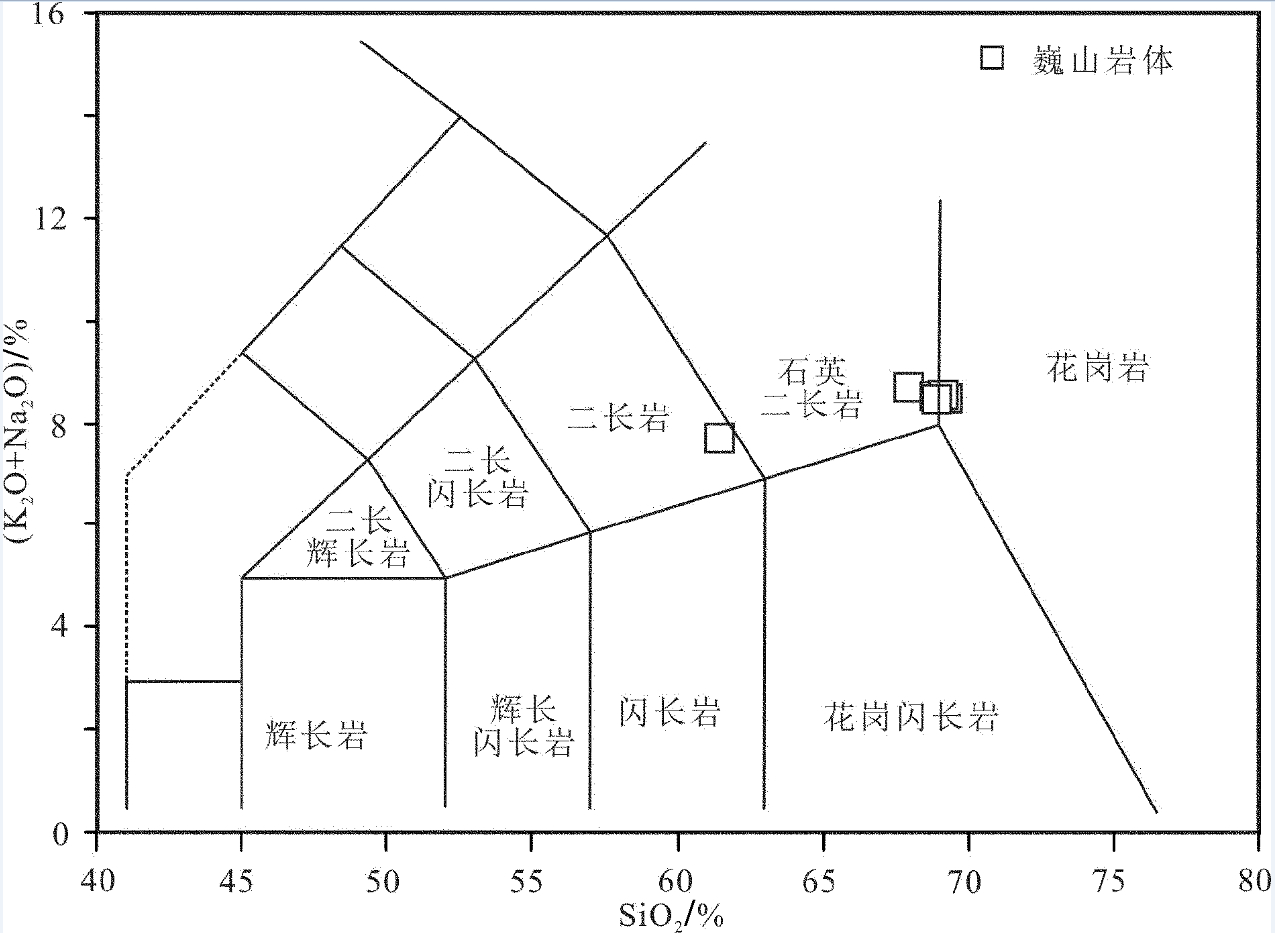2. 国土资源部矿产勘查技术指导中心, 北京 100120;
3. 中国地质调查局成都地质矿产研究所, 四川成都 610081;
4. 兰州大学地质科学与矿产资源学院, 甘肃兰州 730000;
5. 四川省地质调查院, 四川成都 610081
2. Technical Guidance Center for Mineral Resources, Ministry of Land and Resources, Beijing 100120, China ;
3. Chengdu Institute of Geology and Mineral Resources, Chinese Geological Survey, Chengdu 610081, Sichuan, China ;
4. School of Earth Sciences Lanzhou University, Lanzhou 730000, Gansu, China ;
5. Sichuan Institute of Geological Survey, Chengdu 610081, Sichuan, China
印度板块自从新生代以来向欧亚板块进行了持续性的碰撞,并于70/65~40 Ma 发生同碰撞造山作用,导致了青藏高原的形成[1],并且伴随有巨量的钾质-超钾质镁铁质和长英质岩石的产生[2]。该碰撞随后诱发了青藏高原东南侧的挤出构造,沿着北西-西北西向的哀牢山—红河剪切带发生了侧向走滑位移[3],同时沿着哀牢山—金沙江断裂附近产出有北西向的巨型钾质侵入岩带[4](图 1-a)。然而关于这些钾质侵入岩的成因及形成的局部区域构造背景仍然缺乏详尽而统一的认识。部分学者考虑这些钾质岩石的侵位可能与哀牢山—红河剪切带的走滑位移有关[5];然而另外一些学者则认为基性岩浆广泛底侵诱发了该岩浆带的形成[7]。产出在哀牢山—金沙江富碱侵入岩带中的巍山岩体出露于云南省巍山县附近地区[8]。本文对巍山岩体进行了全岩地球化学、Sr-Nd 同位素测定以及LA-ICPMS锆石U-Pb 定年,确定该岩体的岩石学成因及其形成的构造背景,进而探讨哀牢山—金沙江富碱侵入岩带形成的动力学机制。
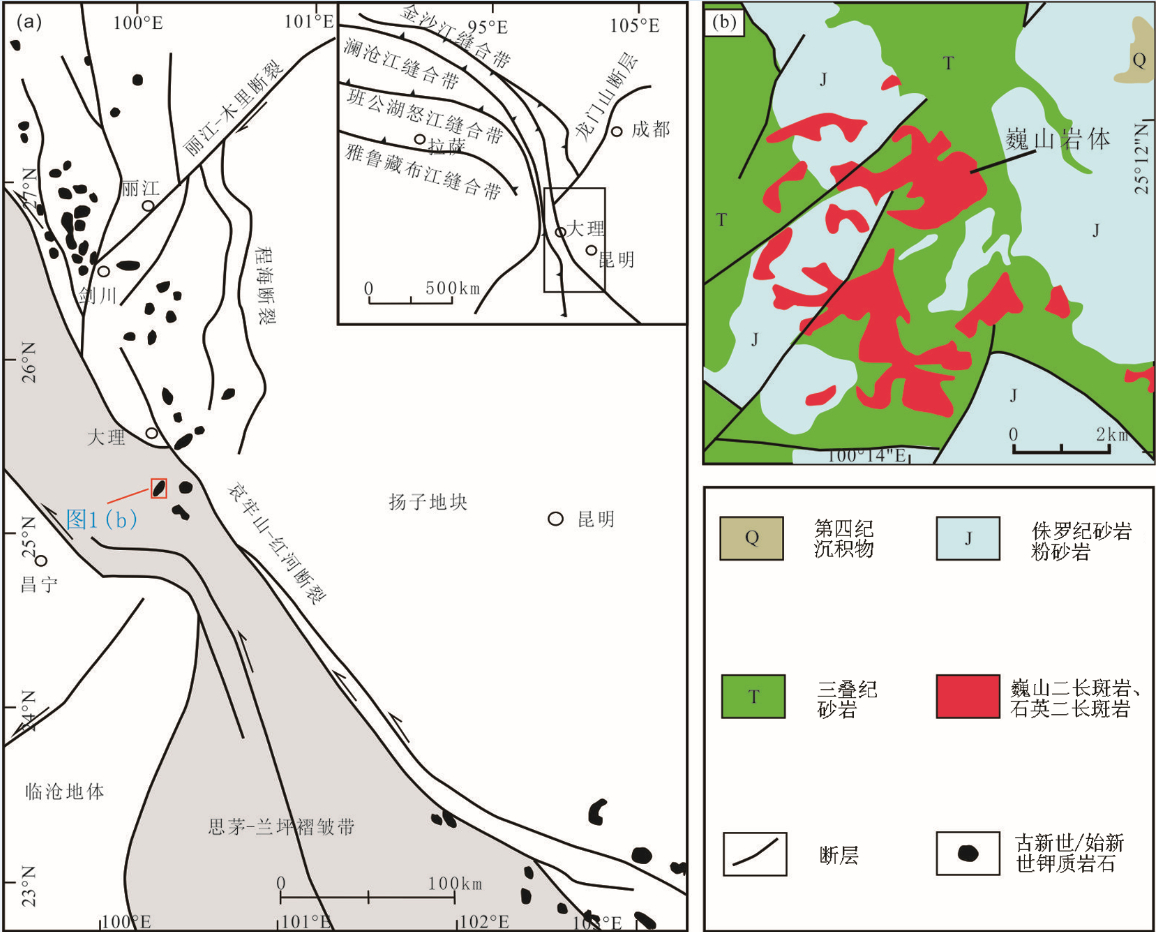
|
图 1 云南西部构造框架简图(a, 据文献[5]修改)及巍山岩体地质简图(b) Fig.1 (a) Simplified tectonic framework of western Yunnan (modified after Huang et al., 2010[5]); (b) Sketch geological map of the Weishan pluton |
巍山岩体侵位于晚三叠世麦初箐组灰色砂岩、细砂岩和早侏罗世漾江组紫红色砂岩、粉砂岩系中(图 1-b)。该岩体由很多个小岩体组成,呈岩株、岩墙、岩床状产出。较大岩体面积大约为5 km2,而小的岩体面积仅有数百平方米。围岩蚀变较弱,偶见烘烤褪色,局部出现绢云母化和角岩化。
2 岩石样品岩相学特征与分析方法 2.1 岩石样品岩相学特征本次研究中,5 个样品均采自巍山岩体的地表露头。样品在TAS 图解中投图落于二长岩和石英二长岩区域(图 2)。手标本和镜下薄片鉴定表明,这些样品呈灰白色,具有典型的斑状结构和块状构造。斑晶主要由石英(QZ)、斜长石(Pl)、钾长石(Kfs)、角闪石(Hb)和黑云母(Bt)组成(图 3),粒径0.3mm~1 cm 不等。基质具有微粒结构,主要由石英、钾长石、斜长石、黑云母和角闪石组成。副矿物主要为榍石、锆石、磷灰石和磁铁矿。
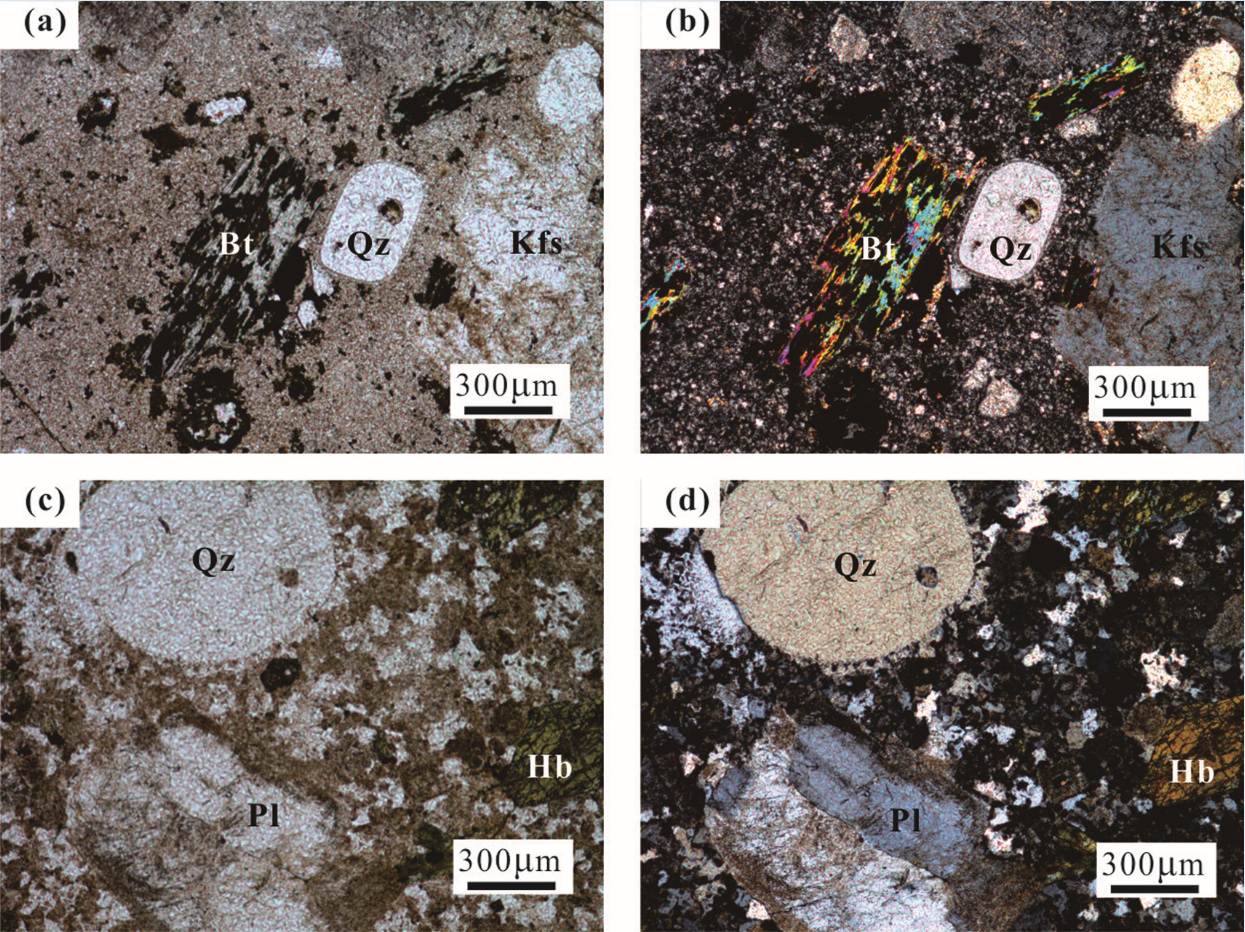
|
图 3 巍山岩体样品显微特征 Fig.3 Microscopic characteristics of the samples collected from theWeishan pluton |
主量元素由国土资源部西南矿产资源监督检测中心采用X 荧光光谱法测试的,所用仪器为Analytical 生产的AXIOS 荧光光谱仪,分析精度和准确度优于5%。微量元素及Sr 同位素分析在中国地质大学(武汉)地质过程与矿产资源国家重点实验室完成。其中,微量元素采用电感耦合等离子体质谱ICP-MS(Agilent7500a)完成。微量元素的分析精度和准确度优于5%。Sr 同位素测试采用Triton-Ti-TIMS仪器分析[10]。
锆石制靶和阴极发光(CL)拍摄在北京锆年领航科技有限公司完成。锆石微量元素含量和U-Pb同位素定年在中国地质大学(武汉)地质过程与矿产资源国家重点实验室(GPMR)利用LA-ICP-MS同时分析完成[11]。U-Pb 同位素定年中采用锆石标准91500 作外标进行同位素分馏校正,每分析5 个样品点,分析2 次91500。对于与分析时间有关的U-Th-Pb 同位素比值漂移,利用91500 的变化采用线性内插的方式进行了校正[12],锆石标准91500 的U-Th-Pb 同位素比值推荐值据[13]。对分析数据的离线处理(包括对样品和空白信号的选择、仪器灵敏度漂移校正元素含量及U-Th-Pb 同位素比值和年龄计算)采用软件ICP-MS DataCal[12, 14]完成。详细的仪器操作条件和数据处理方法同[10, 12, 14]。锆石样品的U-Pb 年龄谐和图绘制和年龄权重平均计算均采用Isoplot3.0[16]完成。
3 分析结果 3.1 岩石地球化学巍山岩体样品的主量、微量和稀土元素的分析结果(表 1)显示:该岩体有着中酸性岩石的组分,其SiO2含量变化范围大,为61.4%~69.3%;所有样品均富钾,具有高的K2O 含量(4.50%~4.98%)和K2O/Na2O 比值(1.10~1.41),在SiO2-K2O 图解中,样品点落于钾玄质和高钾钙碱性系列区域当中(图 4-a)。这些长英质岩石的铝饱和指数ASI(=分子数Al2O3/(CaO+Na2O+K2O))为1.09~1.44,说明岩石是过铝质的(图 4-b),除了样品10WS04-2(具有高的烧失量)。所有样品均相对富集轻稀土元素(LREE),在稀土元素球粒陨石标准化曲线上,明显的可以看出轻重稀土分异明显(图 5-a),(La/Yb)CN=19.0~23.7。同时,巍山长英质岩石的稀土元素配分曲线均没有呈现出明显的Eu 负异常特征(图 5-a),δ Eu=0.89~0.93。而在微量元素蛛网图上,则呈现出相对富集大离子亲石元素(LILE)而相对亏损高场强元素(HFSE),具有明显的Nb-Ta-Ti负异常(图 5-b)。巍山岩体具有和云南西部产出的斜长角闪岩包体相似的Sr-Nd 同位素组成(图 6),但是其ISr 为0.7069~0.7071 比同期的浅色过铝质花岗岩低,εNd(t)值分别为-2.59~-3.73 比它们要高(表 1)。该岩体有着元古代的二阶段Nd 模式年龄(TDM2),分别为1.061~1.153 Ga(表 1)。
|
|
表 1 巍山岩体的主微量、Sr-Nd同位素组分 Table 1 Major, trace elements and Sr-Nd isotope compositions of the Weishan pluton |
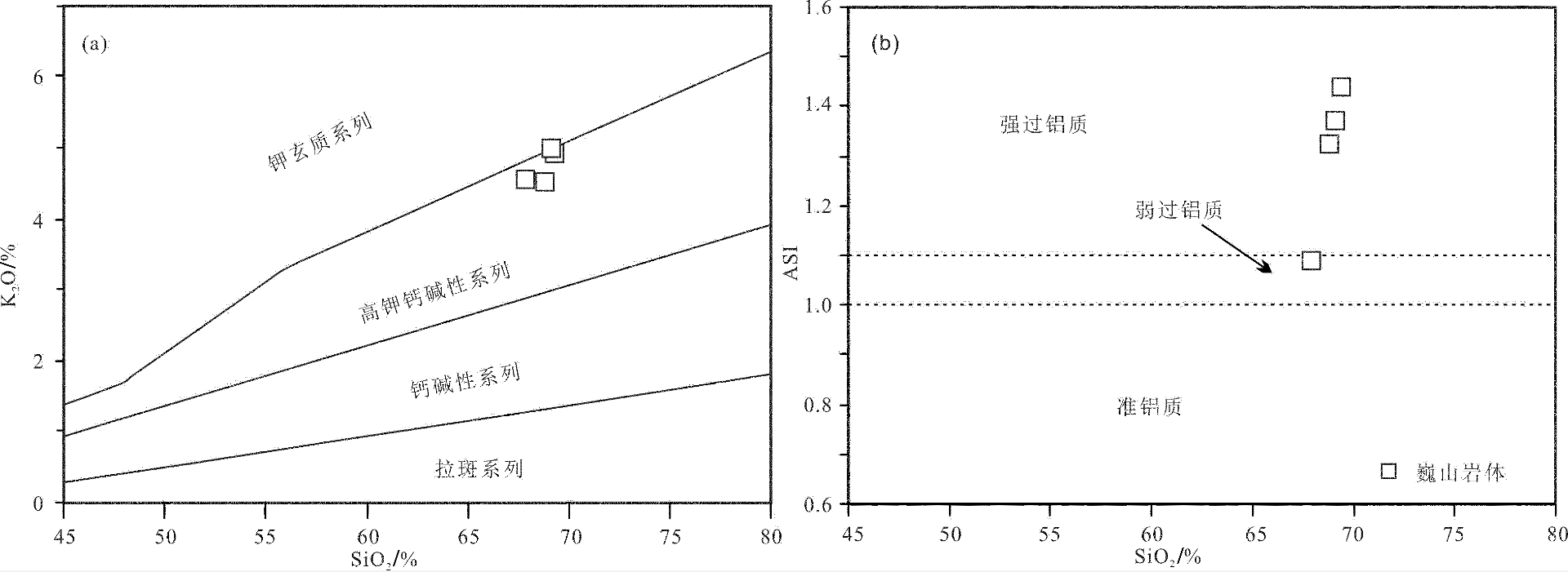
|
图 4 巍山岩体的SiO2-K2O图解(a)和ASI vs. SiO2图解(b) Fig.4 (a) K2O versus SiO2 and (b) ASI versus SiO2 for theWeishan pluton |

|
图 5 巍山岩体稀土元素球粒陨石标准化配分曲线(a,标准化值据Boynton, 1984[17]) 及微量元素原始地幔标准化蛛网图(b,标准化值据McDonough and Sun, 1995[18]) Fig.5 Chondrite-normalized REE patterns (a, normalized values after Boynton, 1984[17]) and primitive mantle-normalized trace element spidergrams (b, normalized values after McDonough and Sun, 1995[18]) for theWeishan pluton |
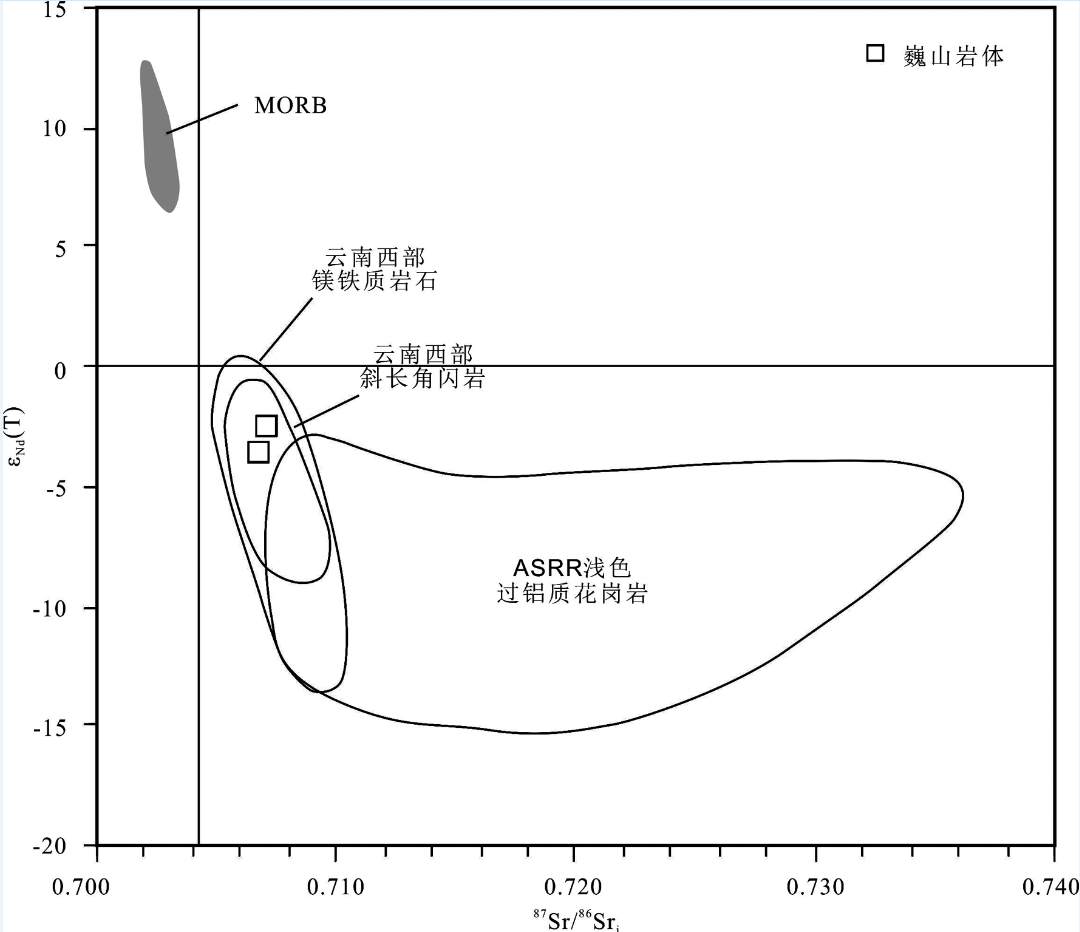
|
图 6 巍山岩体εNd(t)-87Sr/86Sri图解(底图来自[19])ASRR:哀牢山—红河剪切带 Fig.6 εNd(t)-87Sr/86Sri diagram for the Weishan pluton (after [19]) ASRR: Ailao Mountain-Red River shear zone |
本次研究对对采自巍山岩体的样品10WS01-1进行了LA-ICP-MS锆石U-Pb 定年。锆石的阴极发光图像见图 7,U-Th-Pb 同位素测试结果见表 2和图 7。锆石的直径大多数都在150~200 μm。这些锆石为无色至浅褐色,多数呈棱柱状自形晶,呈透明-半透明。它们的Th/U 比值(0.19~0.62 > 0.1,表 2)明显高于变质成因的锆石(Th/U < 0.1[20])。CL图像显示所测锆石具有比较清晰的韵律震荡环带结构,上述特征表明它们均为典型的岩浆成因锆石(图 7)。本次工作共对18 颗锆石进行了测试,获得了18 个测点结果。其中15 个给出了加权平均年龄为(38.5±0.6) Ma,并且在206Pb/238U-207Pb/235U谐和图上,大多数数据点均投在谐和线上或谐和线附近(图 7),谐和度均在95%以上,指示被测锆石未遭受明显的后期热事件的影响。此外,另外3 个测点给出了古生代的年龄,暗示了相应的3 颗锆石可能是岩浆在上升侵位过程中捕获的围岩中的锆石。
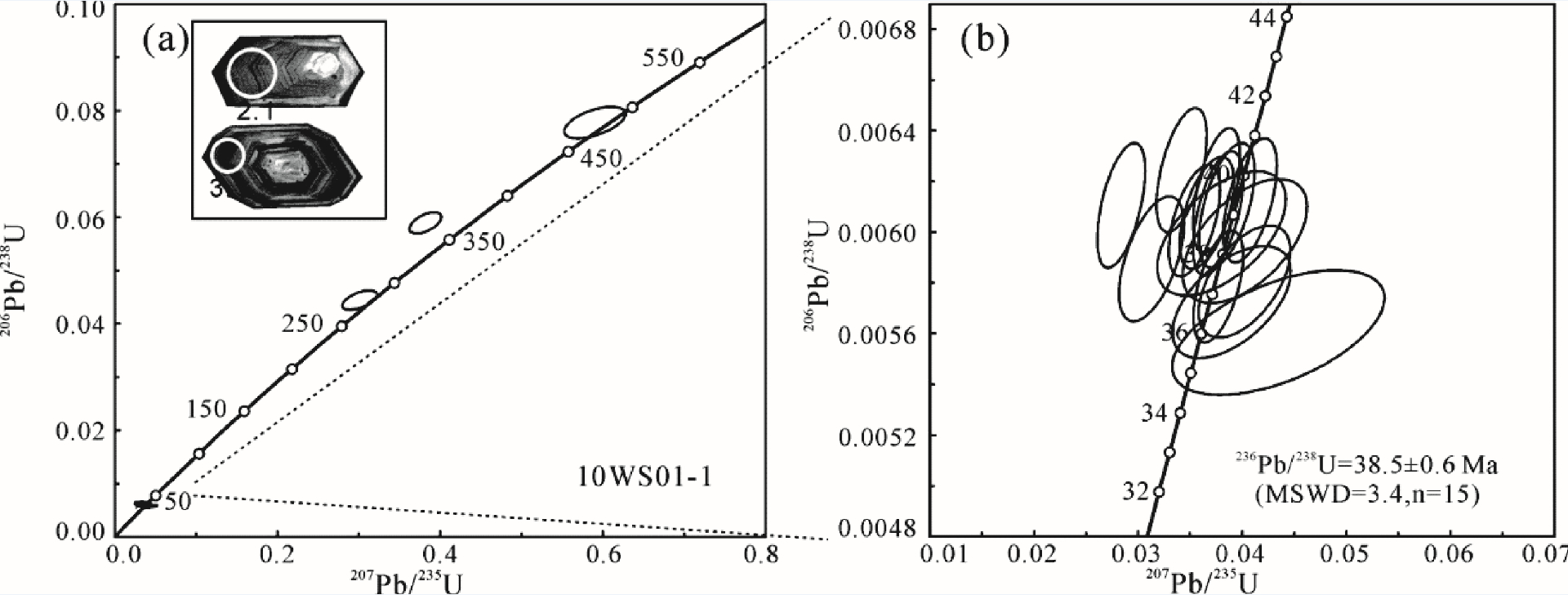
|
图 7 巍山岩体锆石U-Pb谐和图 Fig.7 U-Pb concordia diagrams of zircons for theWeishan pluton |
|
|
表 2 巍山岩体LA-ICP-MS锆石U-Pb定年数据 Table 2 LA-ICP-MS U-Pb dating of zircons from the Weishan pluton |
巍山岩体的岩性组合主要为中性的二长斑岩和石英二长斑岩。前人[7]对岩体中石英二长斑岩分离出的钾长石进行了40Ar/39Ar 定年,测定的年龄为(38.8±0.8)Ma。这与本次LA-ICP-MS 锆石U-Pb定年的结果((38.5±0.6)Ma)在误差范围内基本是一致的。因此,我们考虑巍山岩体的形成时代为38.5 Ma。
巍山岩体具有中酸性的SiO2 含量(61.40%~69.30%),高的Al2O3(14.77%~16.48 %)、Sr (801.56×10-6~1433.42×10-6)、Sr/Y、(La/Yb)N 和低的重稀土(HREE)以及Y(15.28×10-6~18.14×10-6)含量(表 1,图 8),呈现出埃达克质岩石的属性[22, 23]。在稀土配分曲线,没有明显的Eu 负异常出现,并且轻重稀土分异强烈(图 6-a)。具有这种地化特征的岩石主要有4 种成因模式:(1)俯冲板片的部分熔融过程[24, 25];(2)直接来源交代地幔的部分熔融过程[25, 26];(3)剥落下地壳的部分熔融过程[27];(4)增厚地壳的部分熔融过程[28]。
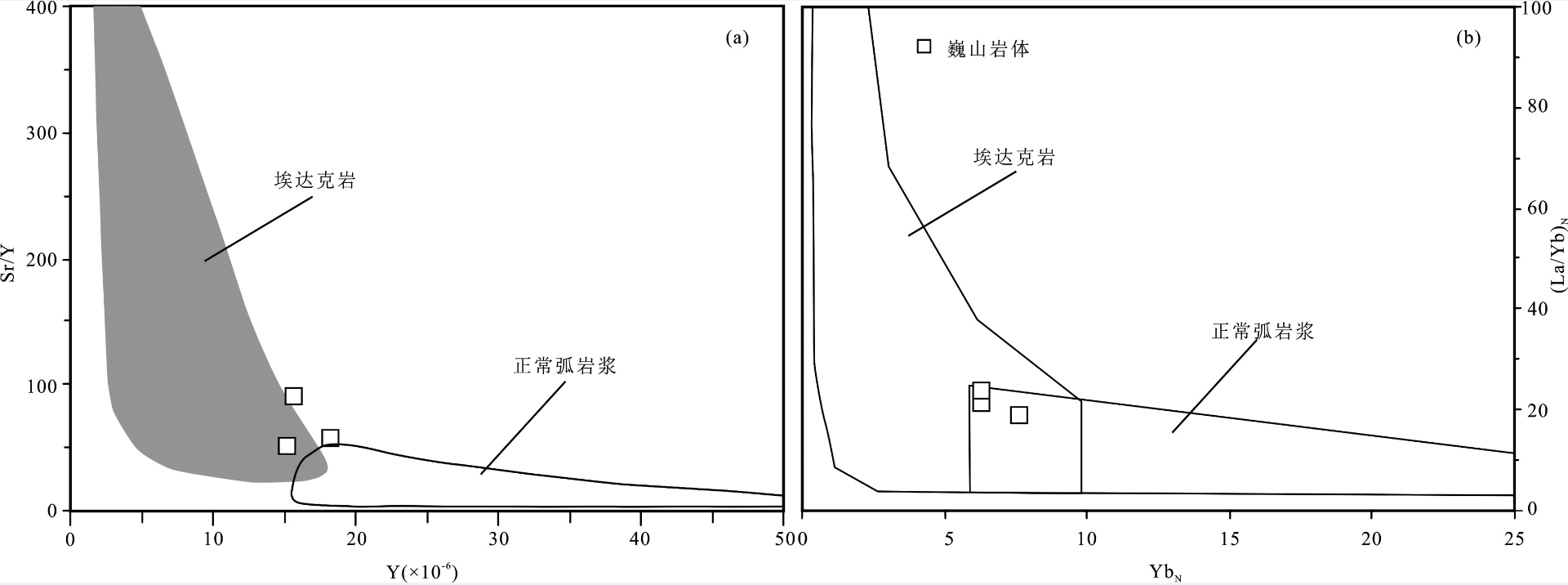
|
图 8 巍山岩体的(a)Sr/Y-Y图解;(b)(La/Yb)N-YbN图解[21] Fig.8 (a) Sr/Y versus Y diagram and (b) (La/Yb)N versus YbN diagram of theWeishan pluton[21] |
来源于俯冲板片部分熔融过程的埃达克质岩石通常是富钠的(K2O/Na2O < 0.4),而且同位素特征和洋中脊玄武岩(MORB)相似[25]。但是巍山岩体有着高的K2O/Na2O 比值(1.10%~1.41%)和明显不同于MORB的Sr-Nd 同位素特征(图 7),说明该岩体并不来源俯冲板片的部分熔融。此外,巍山岩体的形成年龄为始新世,并且没有证据表明云南西部在此时受到了俯冲板片的影响[3]。交代地幔的直接部分熔融可以形成低硅埃达克岩(low-SiO2adakites),它们通常有着低的SiO2(< 60%)和高的MgO含量(> 4%)[22, 25],这些特征与巍山岩体的特征明显不一致,笔者因此也排除这种可能性。地震资料表明现今云南西部地壳厚度为40~55 km[29],而前人[30]利用富钾的长英质侵入体中的镁铁质捕掳体进行了古新世的地壳厚度评估,表明当时的地壳厚度大约为55 km。这就表明了自古新世以来,云南西部地壳厚度没有发生明显的减薄。因此第三种成因即剥落的下地壳的部分熔融形成的巍山岩体这种可能性也是不存在的。因此最有可能的岩石成因就是该岩体形成于增厚地壳的部分熔融过程。
巍山岩体的Sr 和Nd同位素组成和同期长英质侵入体中的斜长角闪岩捕掳体相似(图 7),暗示了可能该岩体由斜长角闪岩部分熔融形成。然而大多数样品都为强过铝质的,具有高的铝饱和指数,其ASI 为1.09~1.44(图 5-b),而通常由斜长角闪岩这种变质火成岩形成的岩石都是I 型岩浆(ASI < 1.1)。因此,高的ASI这说明了其地壳源区为沉积岩或者变质沉积岩。在εNd(t)-87Sr/86Sri 图解中(图 7),巍山岩体比云南西部同期的浅色过铝质侵入岩有着低的ISr和高的εNd(t)组成,我们将这归因于少量地幔物质的加入。此外,相较于纯的增厚地壳部分熔融形成的埃达克质岩石,该岩体中的部分样品有着较高的Mg#、Ni 和Cr 的含量(图 9),这同样暗示了少量地幔物质对该岩体的形成做出了贡献。综上所述,笔者认为巍山岩体可能形成于增厚地壳中的沉积岩或者变质沉积岩发生了部分熔融过程,并且伴随有地幔物质的加入。
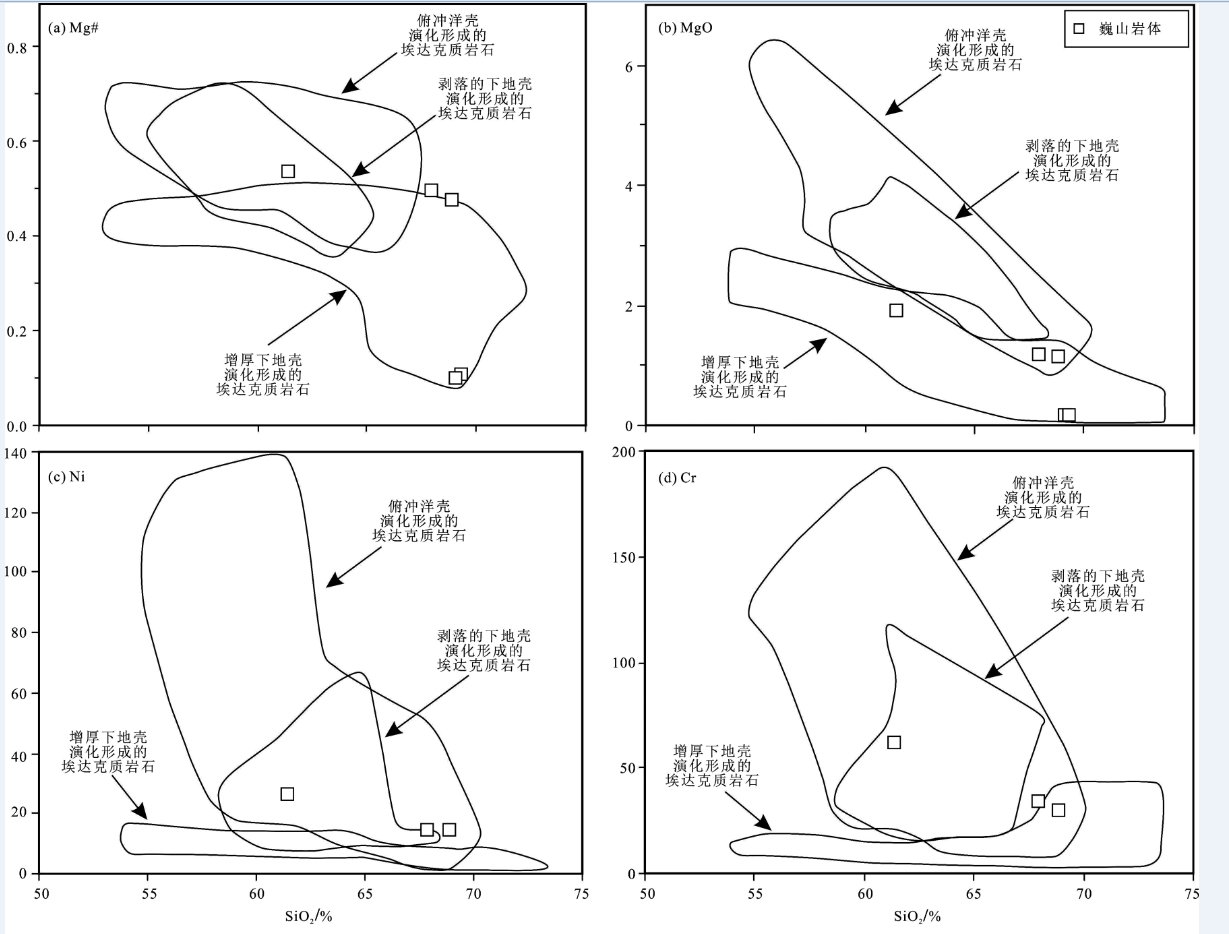
|
图 9 巍山岩体的(a) Mg#-SiO2; (b) MgO-SiO2; (c) Ni-SiO2; (d) Cr-SiO2图解[28] Fig.9 (a) Mg# versus SiO2; (b)MgO versus SiO2; (c) Ni versus SiO2; (d) Cr versus SiO2 diagram of theWeishan pluton[28] |
哀牢山—红河富碱侵入岩带的形成是否和哀牢山—红河剪切带的走滑活动有关,仍然有很大的争议。剪切带东部50 km的未变形的剑川二长岩侵入的锆石U-Pb 年龄为(35.0±0.1) Ma,因此该带的走滑活动被认为早于35 Ma[31]。然而随后,Zhangand Schärer [32]报道了一个来自于剪切带内的页理化的细晶岩墙有着较为年轻的年龄(33.1±0.2 Ma)。此外,一些来自富碱侵入岩带的变形的碱性花岗岩有着相似的年龄((31.0 ± 0.6) Ma 和(33.4 ± 1.7)Ma[6])。因此,哀牢山—红河断裂走滑剪切过程应该发生在31 Ma以后[33]。巍山岩体有着较早的侵位年龄(约38.5 Ma),暗示了它的形成不可能是由剪切带走滑剪切导致的。此外,新生代钾质岩石并不是仅仅出露于哀牢山—红河剪切带附近,而是从青藏高原北缘一直到云南都有分布,延绵超过2000 多千米[3]。这些短期广泛产出的岩浆岩,暗示了强烈的壳幔相互作用过程。自约70/65 Ma开始的印度-欧亚板块持续的碰撞[1],导致了云南西部始新世时期有着增厚的大陆岩石圈。随后,始新世以来这一增厚的岩石圈地幔可能被部分移除[26]。伴随而来的软流圈上涌,为广发的钾质岩浆带的形成提供了热。
5 结论(1)云南西部巍山岩体的锆石U-Pb 年龄为(38.5±0.6)Ma,具有埃达克质岩的地球化学特征。
(2)巍山岩体可能形成于增厚地壳中的沉积岩或变质沉积岩部分熔融过程。
(3)哀牢山—红河剪切带附近的富碱侵入岩带的形成可能与增厚的岩石圈地幔的部分移除有关,并不是剪切带走滑位移作用下形成的。
致谢: 感谢审稿专家和编辑部李亚萍老师给本文提出的宝贵修改意见!
| [1] |
莫宣学. 青藏高原地质研究的回顾与展望[J].
中国地质,2010, 37 (4) : 841 –853.
Mo Xuanxue. A review and prospect of geological researches on the Qinghai-Tibet Plateau[J]. Geology in China,2010, 37 (4) : 841 –853. (in Chinese) (  2) 2)
|
| [2] |
夏斌, 耿庆荣, 张玉泉. 滇西鹤庆地区六合透辉石正长斑岩锆石SHRIMP U-Pb年龄及其意义[J].
地质通报,2007, 26 (6) : 692 –697.
Xia Bin, Geng Qingrong, Zhang Yuquan. Zircon SHRIMP U-Pb age of diopside syenite-porphyry at Liuhe, Heqing, western Yunnan, China[J]. Geological Bulletin of China,2007, 26 (6) : 692 –697. (in Chinese) (  1) 1)
|
| [3] |
Chung S L, Chu M F, Zhang Y Q, et al. Tibetan tectonic evolution inferred from spatial and temporal variations in post-collisional magmatism[J].
Earth-Science Review,2005, 68 : 173 –196.
( 3) 3)
|
| [4] |
张玉泉, 谢应雯, 涂光炽. 哀牢山-金沙江富碱侵入岩及其与裂谷构造关系初步研究[J].
岩石学报,1987, 3 (1) : 17 –26.
Zhang Yuquan, Xie Yingwen, Tu Guangzhi. Preliminary studies of the Alkali-rich intrusive rocks in the Ailaoshan-Jinshajiang Belt and their bearing on rift tectonics[J]. Acta Petrologica Sinica,1987, 3 (1) : 17 –26. (in Chinese) (  1) 1)
|
| [5] |
Huang X L, Niu Y L, Xu Y G, et al. Mineralogical and geochemical constraints on the petrogenesis of post-collisional potassic and ultrapotassic rocks from western Yunnan, SW China[J].
Journal of Petrology,2010, 51 (8) : 1617 –1654.
( 3) 3)
|
| [6] |
Liang H Y, Campbell I H, Allen C M, et al. The age of the potassic alkaline igneous rocks along the Ailao Shan-Red River shear zone:Implications of the onset age of left-lateral shearing[J].
Journal of Geology,2007, 115 : 231 –242.
( 1) 1)
|
| [7] |
Gao S Y, Liu J L, Leiss B, et al. Oligo-Miocene shearing along the Ailao Shan-Red River shear zone:Constraints from structural analysis and zircon U/Pb geochronology of magmatic rocks in the Diancang Shan massif, SE Tibet, China[J].
Gondwana Research,2011, 19 : 975 –993.
( 2) 2)
|
| [8] |
董方浏, 莫宣学, 侯增谦, 等. 云南兰坪盆地喜马拉雅期碱性岩40Ar/39Ar年龄及地质意义[J].
岩石矿物学杂志,2005, 24 (2) : 103 –109.
Dong Fangliu, Mo Xuanxue, Hou Zengqian, et al. 40Ar/39Ar ages of Himalayan alkaline rocks in Lanping basin, Yunnan Province, and their geological implications[J]. Acta Petrol et Mineral,2005, 24 (2) : 103 –109. (in Chinese) (  1) 1)
|
| [9] |
Le Bas M J, Le Maitre R W, Streckeisen A, et al. A chemical classification of volcanic rocks based on the total alkaline-silica diagram[J].
Journal of Petrology,1986, 27 : 745 –750.
( 2) 2)
|
| [10] |
Gao Shan, Rudnick R L, Yuan Honglin, et al. Recycling lower continental crust in the North China craton[J].
Nature,2004, 432 : 892 –897.
( 2) 2)
|
| [11] |
Hu Zhaochu, Gao Shan, Liu Yongsheng, et al. Signal enhancement in laser ablation ICP-MS by addition of nitrogen in thecentral channel gas[J].
J. Anal. At. Spectrom,2008, 23 (8) : 1093 –1101.
( 1) 1)
|
| [12] |
Liu Yongsheng, Gao Shan, Hu Zhaochu, et al. Continental and oceanic crust recycling-induced melt-peridotite interactions in the trans-north China Orogen:U-Pb dating, Hf isotopes and trace elements in zircons from mantle xenoliths[J].
Journal of Petrology,2010, 51 (1/2) : 537 –571.
( 3) 3)
|
| [13] |
Wiedenbeck M, Alle P, Corfu F, et al. Three natural zircon standards for U-Th-Pb, Lu-Hf, trace element and REE analyses[J].
Geostandards Newsletter,1995, 19 (1) : 1 –23.
( 1) 1)
|
| [14] |
Liu Yongsheng, Hu Zhaochu, Gao Shan, et al. In situ analysis of major and trace elements of anhydrous minerals by LA-ICP-MS without applying an internal standard[J].
Chemical Geology,2008, 257 (1/2) : 34 –43.
( 2) 2)
|
| [15] |
Liu Yongsheng, Hu Zhaochu, Zong Keqing, et al. Reappraisement and refinement of zircon U-Pb isotope and trace element analyses by LA-ICP-MS[J].
Chinese Science Bulletin,2010, 55 (15) : 1535 –1546.
( 0) 0)
|
| [16] |
Ludwig K R.
User's Manual for Isoplot 3.00:A Geochronological Toolkit for Microsoft Excel[M]. Berkeley, CA: Berkeley Geochronology Center, 2003 .
( 1) 1)
|
| [17] |
Boynton W V. Cosmochemistry of the rare earth elements:meteorite studies, In:Rare earth element geochemistry (ed. P. Henderson)[J].
Developments in Geochemistry,1984, 2 : 63 –114.
( 2) 2)
|
| [18] |
McDonough W F, Sun S S. The composition of the Earth[J].
Chemical Geology,1995, 120 : 223 –253.
( 2) 2)
|
| [19] |
Lu Y J, Kerrich R, McCuaig T C, et al. Geochemical, Sr-Nd-Pb, and zircon Hf-O isotopic compositions of Eocene-Oligocene shoshonitic and potassic adakite-like felsic intrusions in western Yunnan, SW China:petrogenesis and tectonic implications[J].
Journal of Petrology,2013, 54 (7) : 1309 –1348.
( 2) 2)
|
| [20] |
William I S, Buick A, Cartwright I. An extended episode of early Mesoproterozoic metamorphic fluid flow in the Reynold Region, Central Australia[J].
Journal of Metamorphic Geology,1996, 14 : 29 –47.
( 1) 1)
|
| [21] |
Jiang Y H, Jin G D, Liao S Y, et al. Geochemical and Sr-Nd-Hf isotopic constraints on the origin of Late Triassic granitoids from the Qinling orogen, central China:Implications for a continental arc to continent-continent collision[J].
Lithos,2010, 117 : 183 –197.
( 2) 2)
|
| [22] |
张旗. 埃达克岩研究的回顾和前瞻[J].
中国地质,2008, 35 (1) : 32 –39.
Zhang Qi. Adakite research:retrospect and prospect[J]. Geology in China,2008, 35 (1) : 32 –39. (in Chinese) (  2) 2)
|
| [23] |
邓晋福, 刘翠, 冯艳芳, 等. 高镁安山岩/闪长岩类(HMA)和镁安山岩/闪长岩类(MA):与洋俯冲作用相关的两类典型的火成岩类[J].
中国地质,2010, 37 (4) : 1112 –1118.
Deng Jinfu, Liu Cui, Feng Yanfang, et al. High magnesian andesitic/dioritic rocks(HMA) and magnesian andesitic/dioritic rocks(MA):two igneous rock types related to oceanic subduction[J]. Geology in China,2010, 37 (4) : 1112 –1118. (in Chinese) (  1) 1)
|
| [24] |
Defant M J, Drummond M S. Derivation of some modern arc magmas by melting of young subducted lithosphere[J].
Nature,1990, 347 : 662 –665.
( 1) 1)
|
| [25] |
Martin H, Smithies R H, Rapp R, et al. An overview of adakite, tonalite-trondhjemite-granodiorite (TTG), and sanukitoid:relationships and some implications for crustal evolution[J].
Lithos,2005, 79 : 1 –24.
( 4) 4)
|
| [26] |
Jiang Y H, Jiang S Y, Ling H F, et al. Low-degree melting of a metasomatized lithospheric mantle for the origin of Cenozoic Yulong monzogranitoid-porphyry, east Tibet:Geochemical and Sr-Nd-Pb-Hf isotopic constraints[J].
Earth and Planetary Science Letters,2006, 241 : 617 –633.
( 2) 2)
|
| [27] |
Xu J F, Shinjo R, Defant M J, et al. Origin of Mesozoic adakitic intrusive rocks in the Ningzhen area of east China:Partial melting of delaminated lower continental crust[J].
Geology,2002, 30 (12) : 1111 –1114.
( 1) 1)
|
| [28] |
Hou Z Q, Gao Y F, Qu X M. Origin of adakitic intrusives generated during mid-Miocene east-west extension in southern Tibet[J].
Earth and Planetary Science Letters,2004, 220 : 139 –155.
( 3) 3)
|
| [29] |
Sun Y S, Nafi Toksoz M, Pei S P, et al. S wave tomography of the crust and uppermost mantle in China[J].
Journal of Geophysical Research,2008, 113 (b11307) .
( 1) 1)
|
| [30] |
赵欣, 莫宣学, 喻学惠, 等. 滇西六合地区新生代正长斑岩中深源包体的矿物学特征与成因意义[J].
地学前缘,2003, 10 (3) : 93 –102.
Zhao Xin, Mo Xuanxue, Yu Xuehui, et al. Mineralogical characteristics and petrogenesis of deep-derived xenoliths in Cenozoic syenite-porphyry in Liuhe, Western Yunnan province[J]. Earth Science Frontiers,2003, 10 (3) : 93 –102. (in Chinese) (  1) 1)
|
| [31] |
Schärer U, Zhang L S, Tapponnier P. Duration of strike-slip movements in large shear zones:the Red River belt, China[J].
Earth Planet Sci. Lett,1994, 126 : 379 –397.
( 1) 1)
|
| [32] |
Zhang L S, Schärer U. Age and origin of magmatism along the Cenozoic Red River shear belt, China[J].
Contributions to Mineralogy and Petrology,1999, 134 : 67 –85.
( 1) 1)
|
| [33] |
Lu Y J, Kerrich R, Cawood P A, et al. Zircon SHRIMP U-Pb geochronology of potassic felsic intrusions in western Yunnan, SW China:Constraints on the relationship of magmatism to the Jinsha suture[J].
Gondwana Research,2012, 22 : 737 –747.
( 1) 1)
|

